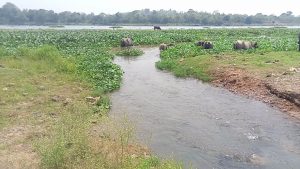Pollution in Brahmani raises health concerns

Rourkela: The Brahmani River, often referred to as the lifeline of Rourkela, is facing alarming levels of pollution posing serious health risks unless immediate corrective action is taken, environmental experts warn. According to the latest annual report from the Odisha State Pollution Control Board (SPCB), the river’s water quality has deteriorated sharply due to the discharge of untreated sewage and industrial waste. The report highlights the infiltration of chemically contaminated water into the groundwater as a major source of river pollution.
Among the 11 rivers tested across the state, the Brahmani displayed some of the poorest water quality indicators. The river’s biochemical oxygen demand, or BOD, ranged from 1.8 mg per litre to as high as 39 mg per litre — far above the safe limit of 5 mg per litre. High BOD levels signal severe organic pollution and elevate the risk of waterborne diseases, the board noted. Despite efforts by the Rourkela Municipal Corporation (RMC), the SPCB and the Sewerage Board, implementation gaps persist. Several major drainage and sanitation projects remain stalled due to land encroachment issues, halting the completion of critical infrastructure intended to protect the river.
For fiscal year 2023–24, crores of rupees were allocated to upgrade the city’s drainage system. However, much of the work remains incomplete. Many major hotels, private medical facilities and industrial units are still not connected to the main sewer network, resulting in the direct discharge of toxic waste into the Brahmani. To curb pollution from chemicals arising out of idol immersion, a dedicated immersion ghat was built in 2023–24 at Balughat at a cost of Rs 1.69 crore. Yet the ramp meant for removing residual waste remains unfinished. The temporary mud ramp has eroded, and the ghat’s drainage channels are clogged with stagnant water, creating foul odours and exacerbating pollution.
Additionally, the gallery area at the Balughat site is unplastered, and concrete layers are already peeling, further exposing lapses in project execution. Asked about the worsening pollution in the Brahmani, Rourkela Municipal Commissioner Ashutosh Kulkarni said, “We will hold consultations with relevant departments regarding the increased pollution levels. Plans are also underway to set up a sewage treatment plant in Koel Nagar, which will significantly reduce contamination in the Koel River, a tributary of Brahmani. In addition, steps will be taken to integrate every pollution-generating establishment into the city’s sewerage system, ensuring more robust drainage management.” Local environmentalists and intellectuals have stressed the urgent need for coordinated action. Cleaning the Brahmani River — the city’s only major water source — is vital not only for environmental preservation but also for protecting public health.
News